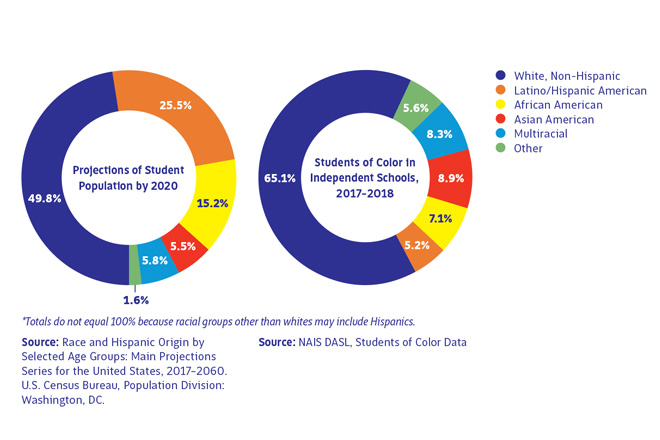Interview by Cecily Garber
Amada Torres is vice president, studies, insights and research at the National Association of Independent Schools.
Net Assets: We’ve heard a lot about changing demographics that are making enrollment more challenging for many independent schools. Can you break that down a little?
Amada Torres: When I joined NAIS in 2005, one of the main topics of concern was competing with other schools for staff. Now enrollment is top-of-mind with heads and boards. Why? We are facing new market conditions, and one of them is the shift in demographics in the U.S. that is coming faster than we expected, and the magnitude of the change is bigger.
In 2011, the U.S. Census found that for the first time, the population of the U.S. under three-years-old was majority non-white. This past summer, the National Population Projections, which is also conducted by the U.S. Census Bureau, found that the majority of children under 18 will be from minority groups in 2020. Demographers have said that by 2045, the U.S. will become a majority minority country, but for children that’s next year. To me, that’s mind-blowing, that students will be majority people of color so soon.
For independent schools, that poses a challenge. The growth in student population is driven by children of color. In 2017-18, 31.5% of independent school students were people of color. Given the current 2020 projections and our diversity numbers, we still have room for improvement in terms of student diversity, especially among Hispanic and African American kids. Of course, this may vary, depending on where you are located. In addition, if our schools are not keeping up with the current makeup of their student population, parents — especially parents of students of color — might think, “that’s not diverse enough. That school doesn’t seem to reflect the community or my family.”
Only 8% of heads are people of color. And by the way, only about a third are women. If the student body continues to change faster than independent school leadership changes, that may exacerbate families’ perceptions.

Net Assets: What demographic changes outside of race are relevant?
Torres: Simultaneously, Americans are having fewer children. Since 2008, the U.S. fertility rate has been declining. I live in Silicon Valley, where most of the houses in my neighborhood were built in the 60s for a family of five or six. Right now, you look around, and most families have four members or fewer. More parents are having just one child. Demographers estimate that to replace a population, you need 2,100 kids per 1,000 women, a 2.1 ratio. That ratio is now 1.77 in the U.S. The main reason the U.S. population is not shrinking is because of immigration.
What does this mean for our schools? They need to work harder and smarter to attract and retain the fewer children out there. This is especially important for K-8 schools, smaller schools and schools in the Mid-Atlantic region, which were the types of schools most impacted by the 2007-2009 recession. Once again, schools need to pay attention to their particular markets. There are low replacement rates in Ohio, Indiana and even the South, where these rates vary between 1.8 and 1.9. The Northeast is worse — the rate is below 1.7 in Maine and Vermont.
What does this mean for our schools? They need to work harder and smarter to attract and retain the fewer children out there.
We are even seeing it in California. Where I live, many independent schools weathered the recession well but then started to struggle. Just a few years earlier, some were expanding, and then the birthrate changes caught up to them.
Net Assets: How does socio-economic diversity factor into these changes?
Torres: We know that a school’s socio-economic diversity is important for some families, but it’s a challenge. With tuitions increasing faster than the cost of living, our schools are becoming unaffordable for larger segments of the population, and even wealthy parents today are requesting financial aid. If your school is struggling with enrollment, you’ll be more prone to assign aid to families who don’t need as much, so you can enroll more students, not just one. I encourage schools to think about their mission and evaluate their value proposition to answer the question on many families’ minds: Is this experience worth paying all this money?
Net Assets: Are other types of schools addressing these changes any better than independent schools?
Torres: Public schools offering strong programs are fierce competitors. Many independent schools are located in neighborhoods with a high tax base, where the public schools are very good.
Then there are charter schools, which were started in the 90s, and are constantly being praised for offering strong academic programs and being diverse. We need to do more research on this, but it’s my hypothesis that sometimes families of color and families of younger children who could afford our schools feel that the better option is a charter school because it combines the best of public and private schools. Charters tend to have more diverse students and faculty, which is also attractive to families of color.
Net Assets: How can schools use demographic data to inform strategy?
Torres: Traditionally schools benchmarked their numbers against other schools, but they also need to consider what their potential market looks like. For example, a school with diversity numbers in the high 30s, say 39%, may look great in comparison to other independent schools in the area. But look at the potential market and the zip codes from which you draw. That comparison may show a population of color in the range of 50-60% and indicate there is still room for improvement.
Study the zip codes the school has traditionally drawn from and projections for the population. We need to be looking ahead. We used to have a lot of children in my neighborhood, for example, but that’s no longer the case. If you find the numbers aren’t favorable, consider, where else can you start outreach? What zip codes may you have overlooked that could be potential new markets?
In some parts of the country, commuting time to the school given the morning traffic may be more relevant than the distance to the school. With younger kids, 30 minutes is usually the maximum driving time. With older kids and good public transportation, that may be different. In addition to commuting time, schools may want to identify prospective families in their surrounding ZIP codes, considering their income and student demographic characteristics. NAIS developed the tool Market View so that schools can see all this data on a map. It’s then easier to understand where current and potential markets are located.
We can’t control changing demographics. They’re not inherently good or bad.
Net Assets: So, is there any hope?
Torres: Most of this information sounds very, “Oh my gosh. We’re in so much trouble.” I’m hoping that schools will see this is as an opportunity to think about not only changes but opportunities to reconsider the way we conduct business. We can’t control changing demographics. They’re not inherently good or bad. It’s up to us to quickly adapt and make changes, and we have been hearing about schools that are thinking ahead. Schools can explore partnering with other types of schools or community centers, social clubs or religious institutions with the idea to create a funnel of new families. It’s an opportunity to think outside the box, which can be exciting.
As an industry, we need to start to work together, whether it’s through shared services like a healthcare consortium to provide insurance at a lower price or a consortium to attract more diverse faculty and staff, so not every school has to struggle alone with the costs of hiring and retaining. Some schools are working with each other in formal partnerships to develop new curriculum. Others are looking at daycares or other schools as feeders. There are ways to continue filling up seats. I’m just hoping this is a good starting point for conversation.
Download a PDF of this article.



